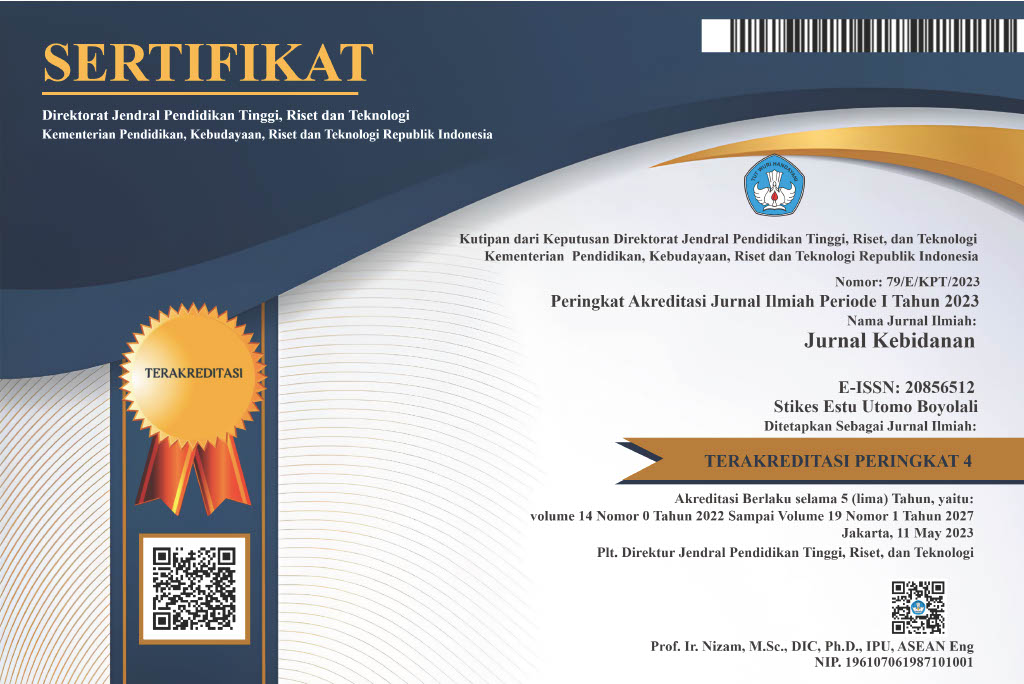-
Titik Wijayanti
-
Atik Setiyaningsih
Abstract
ABSTRAKPerawatan payudara masa nifas (Breast Care Post Partum) merupakan suatu kebutuhan bagi ibu nifas. Dimana dengan perawatan payudara akan sangat membantu pengeluaran ASI yang berimbas pada peningkatan produksi ASI. Dengan produksi ASI yang berlimpah, bayi akan mendapatkan ASI Eksklusif. Cakupan ASI Eksklusif di kab. Semarang  pada tahun 2014 masih dibawah target yaitu 44,3 %, demikian juga di Susukan hanya sebesar 24,8 % (Profil Kesehatan Kabupaten Semarang tahun 2014). Banyak faktor yang mempengaruhi rendahnya cakupan ASI Eksklusif, salah satunya adalah faktor rangsangan yang berupa perawatan payudara. Apabila seorang ibu nifas diberi rangsangan berupa metode breast care secara rutin akan membantu meningkatkan produksi ASI sehingga ibu bisa menyusui secara eksklusif. (Soetjiningsih, 2010). Penelitian yang digunakan adalah penelitian quasi eksperimen dengan pendekatan non equvalentcontrol group desain yaitu suatu penelitian yang terdapat kelompok perlakukan dan kelompok kontrol. (Notoatmodjo, 2005). Kelompok kontrol adalah ibu nifas yang tidak dilakukan breast care dan kelompok perlakuan adalah ibu nifas dengan breast care. Responden adalah ibu nifas hari ke-1 sampai hari ke-7. Untuk kelompok perlakuan diberikan breast care 2x sehari (pagi dan sore)  kemudian diobservasi produksi ASI-nya pada hari ke-8. Responden sejumlah 36 ibu nifas, diambil dengan tehnik purposive sampling terdiri dari 18 ibu nifas dengan breast care  dan 18 ibu nifas tidak diberikan breast care. Hasil perhitungan independent t-test diketahui bahwa besarnya nilai t-hit (16.40) > t-tab (1.691). Dengan demikian dapat disimpulkan bahwa Breastcare Postpastum efektif meningkatkan produksi ASI pada ibu menyusui.Kata Kunci : Produksi ASI, Breast Care post partum..POSTPARTUM BREASTCARE EFFECTIVENESS OF PRODUCTION ASI ABSTRACTBreast Care Post Partum is a requirement for postpartum mothers. Where to breast care will greatly assist ASI expenditures which impact on the increase in milk production. With the abundant production of milk, the baby will be breastfed exclusively. Scope of exclusive breastfeeding in the district. Semarang in 2014 was still below target at 44.3%, so in Susukan only by 24.8% (Semarang District Health Profile 2014). Many factors affect the low coverage of exclusive breastfeeding, one of which is a factor stimulation in the form of breast care. If a given stimulus in the form of postpartum mothers breast care routine methods will help increase milk production so that mothers can breastfeed exclusively. (Soetjiningsih, 2010). Study is a quasi-experimental research with non equvalentcontrol approach to the design of a study group contained treatment group and the control group. (Notoatmodjo, 2005). The control group was postpartum mothers who do not breast care and the treatment group was puerperal women with breast care. Respondents are postpartum mothers day 1 to day 7. For the treatment group given breast care 2x a day (morning and evening) and then observed their milk production on the 8th day. Respondents number 36 puerperal women, taken by purposive sampling technique consisted of 18 puerperal women with breast care and 18 postpartum mother was not given breast care. Results of independent t-test calculation is known that the value of t-hit (16:40) > t-tab (1.691). It can be concluded that Breastcare Postpastum effectively increase milk production in nursing mothers.Keywords: milk production, post partum Breast Care.







.png)










